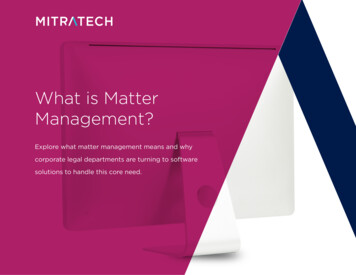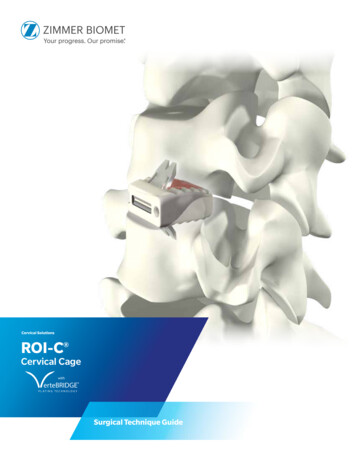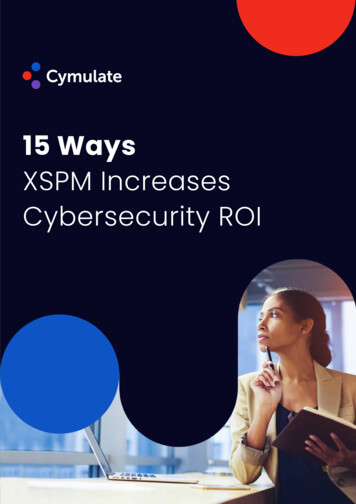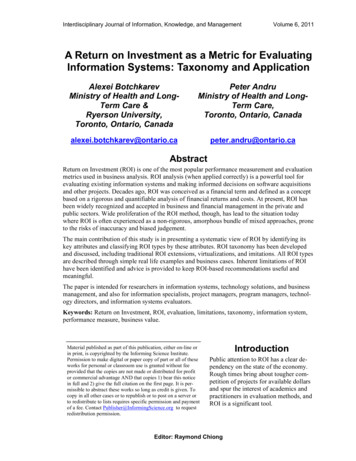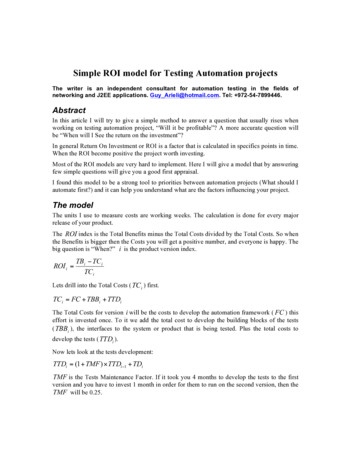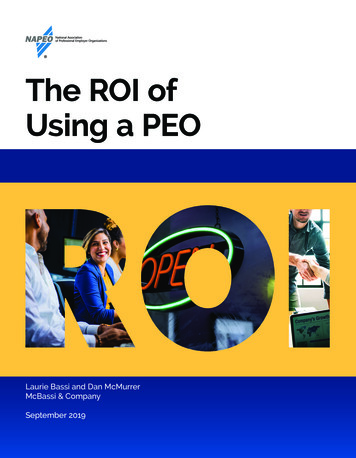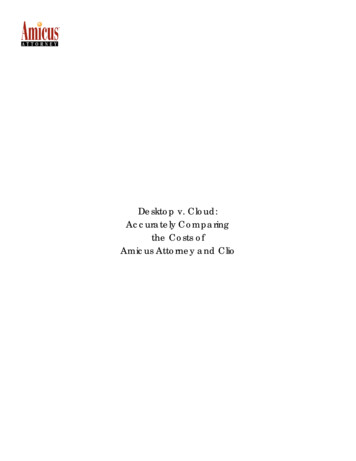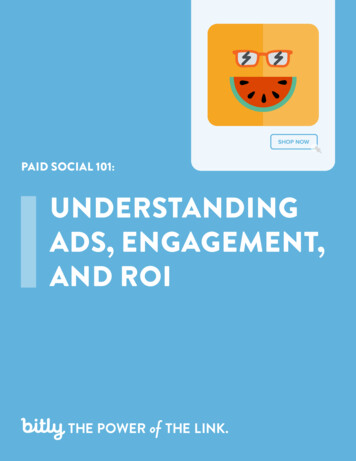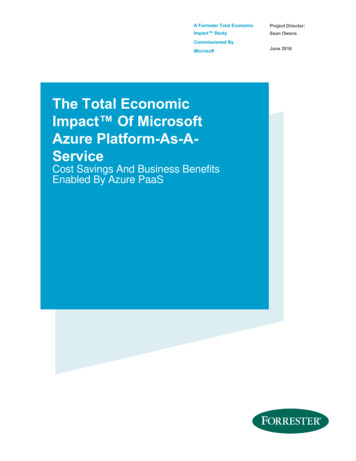
Transcription
A FIRST TRY AT ROI:Ranking 4,500 CollegesFind Your SchoolVisitcew.georgetown.edu/CollegeROIfor online, sortable tables of the4,529 colleges and universities byvarious ROI metrics.Anthony P. CarnevaleBan CheahMartin Van Der Werf2019Centeron Educationand the WorkforceMcCourt School of Public PolicyI
AcknowledgmentsWe are grateful to the individuals and organizations whose generousMany others contributed their thoughts and feedback throughout thesupport has made this report possible: Lumina Foundation (Jamieproduction of this report. We especially are grateful to our talentedMerisotis, Wendy Sedlak, Holly Zanville, and Susan D. Johnson); the Billdesigners, editorial advisors, and printers, whose efforts were vital to its& Melinda Gates Foundation (Patrick Methvin and Jamey Rorison); thesuccessful completion.Joyce Foundation (Sameer Gadkaree); and the Annie E. Casey Foundation(Bob Giloth and Allison Gerber). We are honored to be their partners inThe views expressed in this publication are those of the authors and do not necessarilyour shared mission of promoting postsecondary access, completion, andrepresent those of Lumina Foundation, the Bill & Melinda Gates Foundation, the Joycecareer success for all Americans.Foundation, or the Annie E. Casey Foundation, or any of their officers or employees. Allerrors and omissions are the responsibility of the authors.The staff of the Georgetown University Center on Education and theWorkforce was instrumental in the production of this report fromconception to publication. In particular, we would like to thank Jeff Strohl for research direction; Nicole Smith for economic methodology; Kathryn Peltier Campbell and Michael C. Quinn for editorial andqualitative feedback; Hilary Strahota, Emma Wenzinger, Frank Zhang, Caitlin Panarella,and Allie Babyak for communications efforts, including designdevelopment and public relations; and Andrew Debraggio and Coral Castro for assistance with logisticsand operations.A First Try at ROI: Ranking 4,500 Colleges
Reprint PermissionThe Georgetown University Center on Education and the Workforce carries aCreative Commons license, which permits noncommercial reuse of any of ourcontent when proper attribution is provided.You are free to copy, display, and distribute our work, or include our content inderivative works, under the following conditions: Attribution: You must clearly attribute the work to the GeorgetownUniversity Center on Education and the Workforce and provide a print ordigital copy of the work to cewgeorgetown@georgetown.edu.Our preference is to cite figures and tables as follows:Source: Georgetown University Center on Education and the Workforce, A FirstTry at ROI: Ranking 4,500 Colleges, 2020. Noncommercial use: You may not use this work for commercialpurposes. Written permission must be obtained from the owners of thecopy/literary rights and from Georgetown University for anypublication or commercial use of reproductions. Approval: If you are using one or more of our available datarepresentations (figures, charts, tables, etc.), please visit our website on for moreinformation.For the full legal code of this Creative Commons license, please visitcreativecommons.org.Email cewgeorgetown@georgetown.edu with any questions.
ContentsIntroduction 1Calculating the Potential ROI of College 4Conclusion 17References 18Appendix A. Data and Methodology 19Appendix B. Table of 4,500 Colleges and Universities 24I
FiguresFigure 1 Institutions that primarily grant associate’s degrees have theFigure 3 In the long term, the net present value of future earnings forhighest short-term net present value, while those that primarily grantstudents who attend private nonprofit colleges is greater thanbachelor’s degrees have the lowest. 9that of earnings for students who attend public institutions. 10Figure 2 The median debt at colleges that predominantly offer bachelor’sFigure 4 Even though costs and debt levels for students who attenddegrees is twice as high as the median debt at colleges that predominantlyprivate nonprofit institutions are higher than those of students at otheroffer certificates. 9institutions, their median 10-year earnings are also higher. 10TablesTable 1 The institutions with the highest long-term net present value areTable 4 Institutions at the median of long-term net present value are mostlybachelor’s degree institutions. 6public institutions that grant all levels of postsecondary credentials. 11Table 2 The institutions with the highest net present value in the short termTable 5 Institutions at the 75th percentile of long-term netare mostly institutions granting certificates that take two years or less topresent value are mostly bachelor’s degree institutions. 13complete. 7Table 6 Institutions at the 25th percentile of long-term net presentTable 3 The institutions with the lowest net present value in the long termvalue are mostly less-than-four-year institutions. 15include theological institutions, beauty schools, and a tribal college. 8IIA First Try at ROI: Ranking 4,500 Colleges
IntroductionAs college costs and student loan debt continue to rise precipitously,benefits. A college credential is often essential for starting or changingmore people are wondering if college is worth it. Based on earnings alone,a career. Once enrolled, college students might discover a new careeryes, it is. On average, workers with a bachelor’s degree make 80 percentfield that changes their goals and opens their future, or they might makemore than workers with no more than a high school diploma. At the samefriends who later help their careers or increase their quality of life. Thetime, the potential benefits, as well as the costs, vary notably by institution,emotional and financial aspects of deciding whether and where to attendprogram, and field of study, and students should be informed about thecollege makes it a hard decision to parse using the same factors as otherpotential costs and benefits of their choices.investment choices.12It is difficult to talk about the return on investment (ROI) of college inCollege is expensive, and as with all expensive investments, the potentialthe same terms as other financial investments.3 Investing in a collegereturn is a key consideration when choosing where to enroll and what toeducation has greater immediate effects on a person’s life than investingstudy. Potential students should consider how much it will cost to obtainin the stock market; however, a college degree provides no tangible asset,a credential, and how much they could potentially earn with it. Theyunlike investing in a home. It may take years for the investment to pay off,should also consider the time required to get the degree, the net price,since the value of the degree lies in what a person does with it.5 Investingthe convenience and location of the program, the likelihood that theyin college entails some risk: most students go into debt to pay for college.will graduate, and the amount of time needed to get traction in a career4and to reach prime earning age.6 In addition, they should consider the netHowever, while much has been written about student debt, not all debtpresent value (NPV)7 of their potential future earnings, weighing the costsis bad. Some colleges with high average student debt also have highof investing in college now against the potential gains over time.graduation rates leading to high earnings. Students who stay in school forfour years (or longer) will logically accumulate more debt than studentsThis report provides information about some of these factors by rankingwho stay a year and then drop out. College also has non-monetarycolleges according to return on investment, using new data from the1234567Carnevale et al., The College Payoff, 2011.This point is also made by Oreopoulos and Petronijevic, “Making College Worth It,” 2013, and Webber, “Are College Costs Worth It?,” 2016.Other researchers have looked at measuring the financial returns from colleges, including Avery and Turner, “Student Loans,” 2012, and Barrow and Malamud, “Is College a Worthwhile Investment?,” 2015.This comparison assumes that the risk of the investment in the stock market is the same as the risk of investing in college so that higher expected returns from the stock market are not a compensation for additional risk. See for exampleGreenstone and Looney, “Where Is the Best Place to Invest 102,000 – in Stocks, Bonds, or a College Degree?,” 2011.Baum and Schwartz (2012) make the case that investing in college is similar to making an investment that has to be paid for over time, such as buying a home. They frame the affordability of college not in terms of its total cost but whetherthe benefits from higher earnings can support the debt payments with enough resources left over for other necessities.We do not deduct the opportunity costs of investment in a credential because the foregone earnings vary according to individual circumstances. For a more extended discussion, see Appendix A.Appendix A includes a more detailed description of the data and methodology used in our net present value computations. Other studies of the ROI of a college credential also use net present value as their standard metric. See Webber, “AreCollege Costs Worth It?,” 2016; Strohush and Wanner, “College Degree for Everyone?,” 2015; and Lobo and Burke-Smalley, “An Empirical Investigation of the Value of a College Degree,” 2018.1
expanded College Scorecard, an online database started in 2015 to givebecause they generate strong earnings quickly after studentsmore information about colleges. This report focuses on net presentfinish their credentials. Certificates in nursing are particularlyvalue from college, which was calculated by assuming that earnings 10valuable in the short term. For example, a certificate from Veebyears after first attending are a reasonable proxy for future earnings. WeNassau County School of Practical Nursing in New York ranksalso assumed that the total investment is reflected in the total cost offourth in terms of net present value at the 10-year mark.8college, which the College Scorecard provides as the average annual netprice.9 Debt calculations and values are included in some of our tablesColleges that primarily award bachelor’s degrees have thebecause student debt has become a focus of public attention.highest ROI in the long term. In the long term (40 years), the10highest returns generally come from colleges that primarilyNot everyone who receives a degree earns the median for all people withaward bachelor’s degrees. These degrees produce lower returnsthat credential. Nor does every student end up with the median debt. Butin the short term because they take longer to earn and requireknowing what you could earn and what it will cost you is critical to makingstudents to take on more debt. However, they also producea good decision about whether and where to enroll. For each college, wehigher earnings, so returns on investment in these institutionsevaluated such factors as net price, median debt, and median earnings,will eventually overtake returns from most two-year awards. Forand their related ratios. This analysis is expansive: it ranks more thanexample, Stevens Institute of Technology, in New Jersey, ranks4,500 public, private nonprofit, and private for-profit colleges that offernumber 579 in terms of 10-year net present value, but numberbachelor’s degrees, associate’s degrees, or certificates.15 at a 40-year horizon. The highest long-term returns generally11are at four-year colleges with low median debt levels andOur key findings illustrate how much college rankings can vary dependingdegrees leading to high-paying careers, including high-prestigeon the metric being used.universities like Harvard University and specialized institutionssuch as Maine Maritime Academy.Public colleges have higher ROI than private colleges in the8Community colleges and many certificate programs haveshort term. Public colleges, mostly community colleges, havethe highest ROI in the short term. In the short term (10 years),better returns on investment at short-term horizons (10 years)community colleges, other two-year institutions, and manythan private colleges, particularly for-profit colleges. Tuitioncertificate programs have the highest return on investmentis simply lower at public colleges, and they therefore require1011The US Department of Education has implemented a series of initiatives in recent years to inform students about colleges to help them make better choices. The pendulum has swung from introducing consumer-information tools, suchas the College Navigator, which has gotten little public attention, to taking regulatory gainful employment actions, which were intended to penalize colleges that saddled students with large debts while awarding low-value degrees. Theseregulations have been since rescinded. Now the mood has swung back toward the use of informational transparency about colleges as the department continues to update the College Scorecard with data on earnings and debt by programand institution.The College Scorecard derives the average net price from the total cost of attendance; the average net price in the College Scorecard is not the same as the net price presented in the College Navigator. We assume that the average net priceis a reasonable proxy for amounts required to be continually invested over the course of a student’s enrollment. We do not consider the foregone earnings associated with obtaining a credential.We include metrics using both total cost of attendance and total debt because debt and cost are not always proportional.The rankings exclude colleges that are “not classified” by predominant degree awarded. See Appendix A for a more detailed definition of “predominant degree.” We excluded institutions that did not report data for earnings and net price.2A First Try at ROI: Ranking 4,500 Colleges9
less upfront investment and lower levels of debt. Short-termWhat is net present value?credential programs also take less time to complete (often nomore than two years), so the financial rewards start accumulatingmore quickly. That is why 26 of the 30 institutions with theNet present value can be summed up with the idiom “a birdbest 10-year net present value primarily grant either certificatesin hand is worth two in the bush.” We tend to place moreor associate’s degrees. Ranked according to this metric, thevalue on what we possess now than on what we might attainlist also includes technical high schools that offer college-in the future if we take a risk. Economists evaluating savingslevel certificates, such as Greater Lowell Technical School inand investing behavior try to account for this phenomenonMassachusetts (number 2) and Eastern Center for Arts andby calculating the time value of money: they apply a discountTechnology in Pennsylvania (number 9).rate to expected future cash flows to represent the idea thatwe value future money less than money we have today. TheDegrees from private nonprofit colleges generally have afurther into the future the projected cash flow, the more itshigher ROI in the long term than public universities. In thevalue is discounted. Net present value provides an estimate oflong run (40 years), a degree from a private nonprofit college ishow future earnings are valued in the present.worth more on average than a degree from a public university.Students, on average, take out more than twice as much in loansBecause the earnings from a college credential are oftento attend private colleges, but the median annual earnings 10delayed for lengthy periods, this report uses net present valueyears after enrollment are almost 8,000 higher for graduates ofas a metric for evaluating the worth of a college credential.private colleges than for graduates of public colleges. Over theMany potential students considering a college educationcourse of 40 years, even after paying off higher amounts of debt,will weigh the costs of investing in college now against thea private college graduate will reap a long-term net economicpotential gains over time from having a college credential.gain of 838,000, compared to 765,000 for graduates of publiccolleges. For example, the median debt for Babson CollegeFor a more detailed(private) is 25,000, while the median debt at the United Statesexplanation of netMerchant Marine Academy (public) is 6,500. Lifetime earningspresent value, seefor graduates of Babson College eventually overtake thoseAppendix A.of graduates of the United States Merchant Marine Academybecause the difference in earnings 10 years after enrollment is 8,000 ( 96,100 versus 88,100, respectively).3
Calculating the Potential ROI of CollegeEarnings gains from postsecondary investments differ, but the time spentinto account the full scope of possible value, our findings buttress the ideaearning a credential affects when those earnings begin to accrue. Obtainingthat college is a worthwhile investment. Moreover, we take the positiona postsecondary credential can take less than one year or be extended tothat college should be seen as a long-term investment. The median netfive or six years or more, depending on the kind of investment a studentpresent value for all colleges is 723,000 in the long term (40 years afterwants to make. Differences in credential type (certificate or degree), focusenrollment), but only 107,000 in the short term (10 years after enrollment).(general versus specific), and time to completion all can affect both themagnitude and time horizon of potential earnings. Even without takingWhen earnings begin to accrue matters because people tend to valuefuture earnings less than earnings today—a concept generally referredto as the time value of money. This reflects the tradeoff that someoneis willing to make in the future in order to have the money today. Forexample, someone might prefer to have 80 today versus 100 next year.Our findings buttress the idea thatThis represents a discount or interest rate of 25 percent.college is a worthwhile investment.Earnings further into the future are worth less because they areMoreover, we take the positionfuture earnings minus the total amount invested over time (also discounted)that college should be seen asa long-term investment.discounted more than those in the near future.12 The discounted sum of allis the net present value.13To account for investment returns across different time horizons, thisreport attempts to measure the net present value of attending specificinstitutions.14 The College Scorecard reports earnings 10 years after1213144The interest rate at which future cash flows are discounted is usually linked to the alternative returns that a person could have earned if the money had been used for other investments. We use the yield of a safe investment such as USTreasury securities, which have a long-term return of approximately 2 percent. Future cash flows discounted at a higher rate are worth less than those discounted at a lower rate. Other researchers have used different rates, such as theaverage historical returns to the stock market. Avery and Turner (2012) use 3 percent, while other studies use discount rates of 5 percent or higher. For a review, see Barrow and Malamud, “Is College a Worthwhile Investment?,” 2015. SeeAppendix A for further discussion.Related to the net present value is the internal rate of return, the interest rate that makes the total investment equal to the positive earnings. We calculated the internal rate of return but do not present it here because this rate of return cannotbe used to consistently rank investments when the time to positive earnings or investment amounts vary.See Appendix A for a more detailed explanation of our data and methodology.A First Try at ROI: Ranking 4,500 Colleges
students enter each institution, and those figures are used as the basis topositive earnings for the next five years.18 At a 40-year horizon, earningsproject their earnings into the future.15 We assume no earnings increasesflows from a certificate are considered to be positive for 39 years while forafter 10 years, so our estimates can be considered to be at the lower enda bachelor’s degree, earnings flows are positive for 35 years.19of possible outcomes.16We calculated the net present value at different time horizons associatedwith investing in postsecondary education for every college in theWhen earnings begin to accruenation that primarily awards bachelor’s degrees, associate’s degrees, andmatters because people tendstudents or less. These smaller colleges are included in this analysis becausecertificates. More than 1,200 of these colleges are very small, with 250to value future earnings lesschanges to federal policy that have been proposed to meet the needs ofthan earnings today—a conceptqualify for Pell Grants. For example, the JOBS Act of 2019 would allowgenerally referred to as theduration.20adult students would allow students in smaller and shorter programs tostudents to receive Pell Grants for programs as short as eight weeks intime value of money.Looking at a 10-year horizon, a student considering an investment in acertificate (assuming completion in a year) would have positive earningsfor nine years and incur an investment cost only in the first year. Thesame student considering an investment in a four-year degree (assuminggraduation in five years) would incur costs for the first five years17 and151617181920Webber (2016) finds that depending on the choice of major and costs, the age at which the net present value of a bachelor’s degree becomes positive can be as early as 31 years old for STEM majors and as late as 64 years old for arts andhumanities majors.We also assume no increases in the cost of postsecondary investment, including tuition. This assumption matters less at long horizons but would overestimate the economic value in the short term if costs are actually increasing.Lobo and Burke-Smalley (2018) find that as the time to graduation increases, the net present value of a bachelor’s degree falls. Their net present value calculations also deduct lifetime earnings of a high school graduate. For someone whograduates in six years, their net present value of lifetime earnings (up to age 70) is negative. For education majors, the net present value is negative if the student does not finish within four years.We assume that costs are incurred for five years even for institutions with low graduation rates where the likelihood of dropping out before five years is higher. For institutions with low graduation rates, our estimates of negative cash flowsmost likely exceed actual costs and bias the net present value downward. Median earnings reported in the College Scorecard include completers and non-completers, so positive cash flows already incorporate the probability of not finishing.We did not attempt to match the graduation rate with the share of the earnings cohort that was not working.For a 20-year-old who is considering alternatives, a 10-year horizon would represent the payoff when the student is 30 years old, while a 40-year horizon would represent the payoff when the student is 60 years old. The two time horizonstherefore help answer the question, “Where should I expect to be when I am 30 (or 60)?” This may not be relevant for non-traditional students who may be returning to college at older ages.Kreighbaum, “Brewing Battle Over Pell Grants,” 2019.5
Here are some of the most notable findings:The colleges with the best long-term net economic gains are all four-year institutions. Eight ofthe 10 are private nonprofit institutions. The two public institutions are maritime academies:Maine Maritime Academy and the US Merchant Marine Academy. Degrees from six of the 10institutions have a net present value of 2 million or more at the 40-year horizon. The followingtable highlights the variation in different metrics, and how value can change dramatically overtime. Looking at a 10-year horizon, Babson College’s net present value ranks number 304. At the40 year horizon, however, Babson’s net present value ranks in the top 10 (Table 1).Table 1. The institutions with the highest long-term net present value are bachelor’s degree 0-yearNPV rank40-year NPV10-yearNPV rank10-year NPVGraduationrateMediandebtAlbany College of Pharmacyand Health SciencesNYBachelor’sPrivatenonprofit1 2,722,0006 385,00074% 25,000St. Louis College of PharmacyMOBachelor’sPrivatenonprofit2 2,714,0005 389,00072% 19,500Massachusetts Collegeof Pharmacy and HealthSciencesMABachelor’sPrivatenonprofit3 2,421,00093 247,00076% 25,000Massachusetts Institute ofTechnologyMABachelor’sPrivatenonprofit4 2,273,00020 311,00093% 15,346Stanford UniversityCABachelor’sPrivatenonprofit5 2,068,00021 307,00094% 10,874Maine Maritime AcademyMEBachelor’sPublic6 2,043,00086 251,00066% 27,0007 1,985,000304 184,00091% 24,875Babson CollegeMABachelor’sPrivatenonprofitHarvard UniversityMABachelor’sPrivatenonprofit8 1,967,00037 286,00097% 7,000Georgetown UniversityDCBachelor’sPrivatenonprofit9 1,950,000215 198,00094% 14,750United States Merchant MarineAcademyNYBachelor’sPublic10 1,949,00028 298,00078% 6,500Source: Georgetown University Center on Education and the Workforce analysis of data from the US Department of Education College Scorecard, 2019.6A First Try at ROI: Ranking 4,500 Colleges
In the short term, eight institutions that primarily award certificates have the highest economicvalue. Of the top 10 colleges, only two are predominantly bachelor’s degree-grantinginstitutions. Both of those colleges, St. Louis College of Pharmacy and Albany College ofPharmacy and Health Sciences, also have the highest net present value rankings at the 40-yearhorizon. At the eight top certificate-awarding institutions, five of the programs with the highesteconomic value are related to nursing (Table 2).Table 2. The institutions with the highest net present value in the short term are mostly institutions granting certificates that take two years or less to arNPV rank40-year NPV10-yearNPV rank10-year NPVGraduationrateMediandebtPutnam WestchesterBOCES-Practical NursingProgramNYCertificatePublic52 1,497,0001 431,00080% 7,000Greater Lowell TechnicalSchoolMACertificatePublic65 1,444,0002 417,00090% 5,500Southern WestchesterBOCES-Practical NursingProgramNYCertificatePublic55 1,487,0003 400,00082% 9,500Veeb Nassau County Schoolof Practical NursingNYCertificatePublic75 1,403,0004 393,00088% 9,500St. Louis College ofPharmacyMOBachelor’sPrivatenonprofit2 2,714,0005 389,00072% 19,500Albany College of Pharmacyand Health SciencesNYBachelor’sPrivatenonprofit1 2,722,0006 385,00074% 25,000Rockland County BOCESPractical Nursing ProgramNYCertificatePublic117 1,293,0007 383,00088% 6,634Delaware County TechnicalSchool-Practical NursingProgramPACertificatePublic143 1,257,0008 363,00060% 16,450Eastern Center for Arts andTechnologyPACertificatePublic133 1,274,0009 358,00069% 9,500Ocean CorporationTXCertificatePrivate forprofit107 1,313,0009 358,00077% 9,500Source: Georgetown University Center on Education and the Workforce analysis of data from the US Department of Education College Scorecard, 2019.7
A wide variety of institutions have low long-term economic value. The bottom 10 institutions rangefrom theological institutions to beauty schools to colleges specializing in the arts. They are evenlydivided between two- and four-year institutions. The short-term (10 year) net present value for allthese institutions is less than 60,000. Two have a negative net present value (Table 3).Table 3. The institutions with the lowest net present value in the long term include theological institutions, beauty schools, and a tribal rNPV rank10-year40-year NPV NPV rank10-year NPVGraduationrateMediandebtYeshivath ViznitzNYBachelor’sPrivatenonprofit4520 294,0004296 24,00085%NAPhagans Medford BeautySchoolORCertificatePrivate forprofit4521 286,0003847 52,00075% 6,765Pennsylvania Academy ofthe Fine ArtsPABachelor’sPrivatenonprofit4522 284,0004527- 94,00055% 19,500Clarksburg Beauty Academyand School of MassageTherapyWVCertificatePrivate forprofit4522 284,0004208 33,00055% 6,333Yeshiva Gedolah Imrei YosefD’spinkaNYBachelor’sPrivatenonprofit4524 276,0004357 17,00061%NAPaul Mitchell the SchoolLouisvilleKYCertificatePrivate forprofit4525 258,0004228 31,00059% 11,988Leech Lake Tribal CollegeMNAssociate’sPublic4526 256,0003813 53,00016%NARabbinical College of OhrShimon YisroelNYBachelor’sPrivatenonprofit4527 248,0004475- 20,00040%NACommonwealth 8 242,0004395 8,00080%NAElevate Salon InstituteChubbuckIDCertificatePrivate forprofit4529 240,0004429 080% 13,000Source: Georgetown University Center on Education and the Workforce analysis of
Attribution: You must clearly attribute the work to the Georgetown University Center on Education and the Workforce and provide a print or digital copy of the work to cewgeorgetown@georgetown.edu. Our preference is to cite figures and tables as follows: Source: Georgetown University Center on Education and the Workforce, A First
